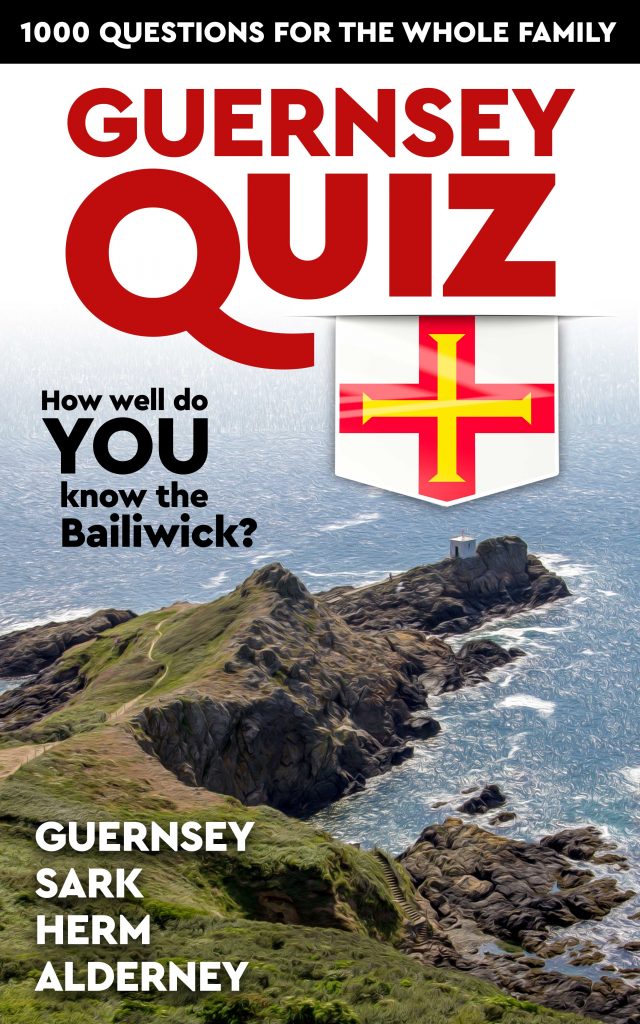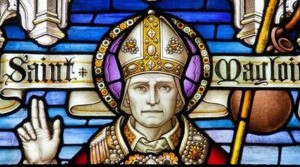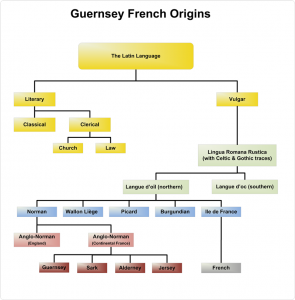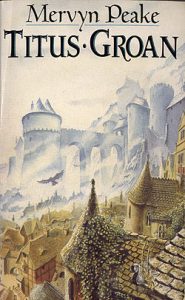The Guernsey Quiz 2 : How Well Do You Know the Bailiwick?

Test your knowledge with these 20 questions we’ve gathered from Lukas Aleksandr’s excellent book “Guernsey Quiz Book : 1000 questions for the whole family”.
We’ve assigned our own made up rating system, below, for your score … enjoy ! 🙂
| Ratings | ||
| 20 correct | ………… | Super Sarnian ! |
| 15-19 correct | ………… | Splendid Sarnian |
| 11-14 correct | ………… | ‘Satisfactory Sarnian’ (but some work needed) |
| 6-10 correct | ………… | ‘Sub-Standard Sarnian’ (some serious work needed) |
| 0-5 correct | ………… | You must be from Jersey! |
(1) Who is the patron saint of Sark?
St Magliore
You can read more about St. Magloire and his link to Sark in our article entitled St Magloire – Patron Saint of Sark. |
(2) On which two Guernsey beaches could you watch motor racing? |
|||||||||
(3) Against which team would Guernsey be competing if its opponents in a Muratti football game were wearing blue and white?
Alderney Some Alderney themed Muratti factoids for you …
|
||||||||||
(4) What does “hougue”, derived from Norse, actually mean?
Hill Some other Norse themed factoids for you …
|
||||||||||
(5) According to the census of 2001, how many people in Guernsey are fluent Guernesiais speakers?
Just 2%
You can read more about Guernsey’s own language in our article entitled Guernsey Patois – A Language Apart or maybe test yourself to see how much patois you relly know in our article Brush up on your Patois – Guernsey French Phrases. |
||||||||||
(6) When was Guernsey's Patron Saint St Sampson born: 485, 585 or 685?
AD 485
You can read more about Saint Sampson in our article Saint Sampson and the Christianisation of Guernsey. |
||||||||||
(7) From which country was the Guernsey Lily introduced to the island?
South Africa
One local legend states that the first bulbs were washed ashore on the west coast of Guernsey from a Dutch ship wrecked whilst en route from Japan. You can read more about Guernsey’s National Flower in our article entitled Guernsey Legends – The Guernsey Lily. |
||||||||||
(8) When was the Muratti football competition founded?
1905 The first Muratti Football competition took place at Springfield in Jersey between Guernsey and Jersey on Apr 27 1905 where Guernsey win 1-0 . The competition is actually named after Muratti cigarettes, the sponsors who purchased the original trophy. You can read more about the Muratti in our article entitled The Muratti – Origin of a Local Showdown. |
||||||||||
(9) Guernsey is home to the UK’s oldest pillar box still in use. Where is it?
Union Street, St Peter Port
It was in October 1980 that the Guernsey Post Office changed their image by painting all their boxes deep blue. Guernsey’s number 1 box was situated in the grounds of a hotel. When the Post Office workers arrived, armed with paint and brushes, the owner of the hotel stopped them from applying blue paint to the oldest box in the land . He contacted certain States members and over the next few years numerous debates and letters concerning the colour of this one particular post box filled the pages of the Guernsey Press. In September, 1987, the workers returned to Union Street, only this time their paint pot contained the original maroon paint. You can read more about Guernsey’s postal claim to fame in our article entitled Guernsey on the Map – The First and Oldest Post Box in the British Isles. |
||||||||||
(10) When does the Lieutenant Governor of Guernsey vote in the States of Deliberation?
A trick question, the answer is … never The role of the Lieutenant Governor today is largely as the Crown’s representative as Guernsey, whilst independent from teh UK government, remains a Crown dependency. This means that many of Guernsey’s Laws require the approval of the Crown. In the past the powers of the various Governors and Lieutenant Governors were considerably greater than they are today with their ability to meddle with local affairs often causing resentment and outright rebellion. There are several instances where the Guernsey people appealed directly to their sovereign about dictatorial and heavy handed rule by her Governors. One of the most notable being in 1607 when the States of Guernsey appealed to James I about the then Governor Sir Thomas Leighton. Royal commissioners were appointed and did uncover abuses of power that led to some swinging changes in the Governor’s power, such as : *
|
||||||||||
(11) Which film, starring Peter Sellers and Charles Aznavour, was filmed entirely in Guernsey in 1973?
The Blockhouse
|
||||||||||
(12) The “-ey” at the end of Guernsey’s name is an Old Norse affix meaning what?
Island The name “Guernsey”, as well as that of neighbouring “Jersey”, is of Old Norse origin. The second element of each word, “-ey”, is the Old Norse for “island”, while “Guern” resembles the Spanish Cuerno, French Coi(r)n, Dutch Hoorn, Frisian Hoarn, Swedish Hörn and Swiss Gorn, all meaning “corner”. Hence “Guernsey” may originally translate as “Corner Island
Scholars also variously surmise that Jersey and Jèrri derive from jarð (Old Norse for “earth”) or jarl (earl), or perhaps a personal name, Geirr (“Geirr’s Island”). You can read more about the local Patois’ in our article entitled The Origins of Guernsey French and Other Channel Island Languages. |
||||||||||
(13) What does Torteval mean in Guernesiais?
Twisting valley In Guernésiais, people from Torteval were nicknamed “ânes à pid dé ch’fa”, or “donkeys with horse’s hooves”. You can read more about the meaning of some of Guernsey’s place names in our article entitled Guernsey Place Names & Their Meanings. |
||||||||||
(14) By which Channel Island location was Enya’s album Dark Sky Island inspired?
Sark
|
||||||||||
(15) Where did the last public execution take place on Guernsey?
St James Street On 10th February 1854 John Tapner was hanged in St James Street in St Peter Port for the crime of murder, he was the last person to be publicly executed on Guernsey. Tapner, who was English, had been living in St Martins when 74-year-old Elizabeth Saujon was murdered in her home in St Peter Port on 18 October 1853. Saujon had been knocked unconscious and left to die in her burning house. Tapner was arrested and tried for the murder of Saujon. At the trial, it was revealed that Tapner’s mistress — who was his wife’s sister — lived with Saujon. There were also reports of some of Saujon’s belongings being discovered near Tapner’s house in St Martins. While Tapner admitted to being in St Peter Port the evening of the murder, he denied any involvement in the fire or Saujon’s death. It was never clear what Tapner’s motive would have been for killing Saujon and burning down her house. Tapner was convicted of murder by the Jurats and sentenced to death by hanging. Victor Hugo (who would later move to Guernsey) and 600 residents petitioned the Home Secretary of the United Kingdom, Lord Palmerston, to commute Tapner’s sentence. However Palmerston refused, and Tapner was hanged on 10th February 1854 in St Peter Port. His execution was unfortunately botched and instead of a clean death Tapner died of strangulation. No one was executed by Guernsey after Tapner’s execution. Guernsey abolished the death penalty in 2003. |
||||||||||
(16) Frank Falla was appointed to edit the Guernsey Evening Press during the occupation. On the side he also worked on which clandestine publication?
GUNS (Guernsey Underground News Sheet)
Islanders became increasingly angry with the German occupation as the war went on. The Germans had seized control of the island’s media outlets, so some islanders resisted this by printing illegal news sheets. The most well-known was the Guernsey Underground News Sheet (GUNS). GUNS published BBC news, illegally received, on a single news sheet. As editor in chief Falla was able, through strategic placement of stories handed to him by the German authorities, to make it possible for islanders to easily distinguish between German news and stories emanating from Guernsey journalists. Falla was eventually betrayed by an Irish collaborator and, along with his peers who helped to produce GUNS, was deported to Germany. Falla survived, though other members of the organisation never returned home from Germany. |
||||||||||
(17) Which renowned series of fantasy novels was largely written on Sark by Mervyn Peake?
Gormenghast
The then surviving feudal system of government on Sark undoubtedly had an influence on his work. In one of the chapters of Gormenghast, where Titus and his mother attempt to trace Steerpike’s whereabouts, the placenames she reels off are all places on Sark. |
||||||||||
(18) When were tomato plants first introduced to Guernsey? 1665, 1765, 1865 or 1965?
1865
You can read more about Guernsey’s famous Tomato industry in our article entitled The Guernsey Tom. |
||||||||||
(19) When did Guernsey adopt its current flag?
1985
The golden cross has its origins in the 11th century when William the Conqueror, the then Duke of Normandy (of which the Channel Islands were a part of) was given the cross in a banner from Pope Alexander II, prior to embarking on his conquest of England in 1066. The red cross of St George cross represents the historic ties between Guernsey and the English crown. You can read more about the Guernsey Flag in our article entitled Flags of the Channel Islands. |
||||||||||
(20) When the last monks left the priory on Lihou, where did they go?
Mont St Michel
You can read more about Lihou Priory’s colourful history in our articles entitled Scandal & Heresy in the Priory of Notre Dame de Lihou ? and Death & Retribution in the Priory of Notre Dame de Lihou. |
||||||||||
The questions above have been reproduced with kind permission from Lukas Aleksandr’s book “Guernsey Quiz Book : 1000 questions for the whole family”. If you want to buy the full 1,000 questions the check it out here >>>.


















